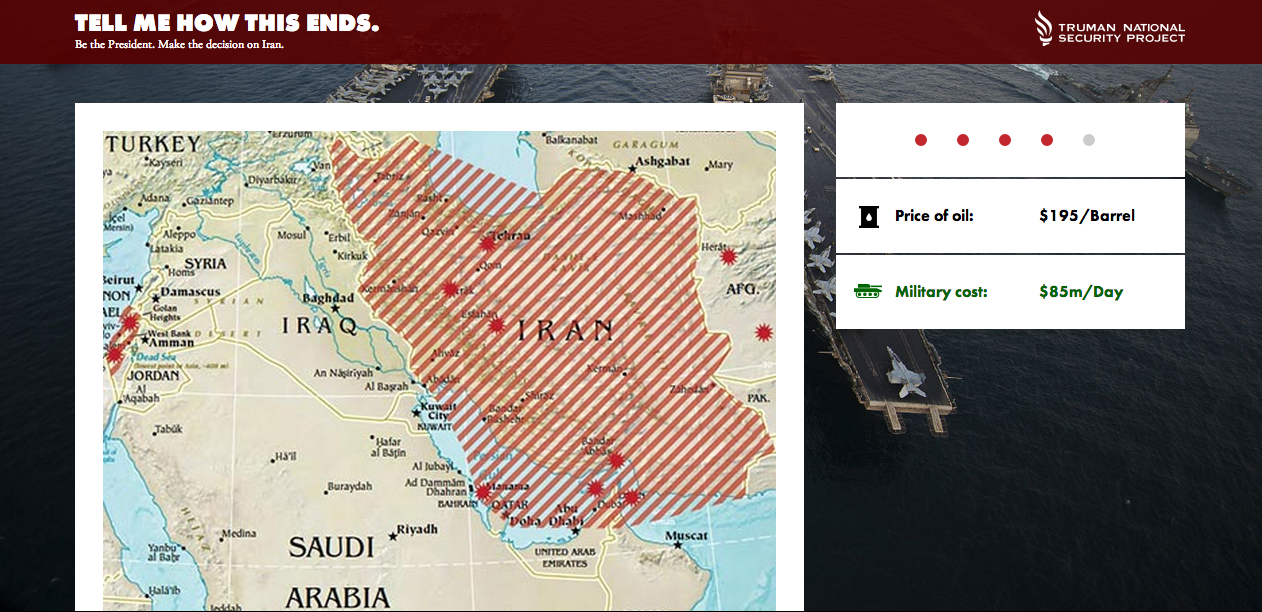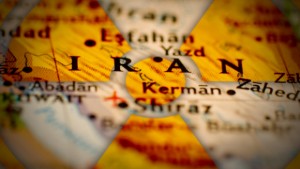The Truman National Security Project has created an interactive version of a war game with Iran. The goal is to highlight the costs of using the military option — financially massive and downright bad for US allies and forces in the region — on the Islamic Republic.
The game [...]]]>
 The Truman National Security Project has created an interactive version of a war game with Iran. The goal is to highlight the costs of using the military option — financially massive and downright bad for US allies and forces in the region — on the Islamic Republic.
The Truman National Security Project has created an interactive version of a war game with Iran. The goal is to highlight the costs of using the military option — financially massive and downright bad for US allies and forces in the region — on the Islamic Republic.
The game was developed in consultation with senior former defense department officials and military experts. Users are put in the shoes of the President who is given various modes of deployment for attacking Iran after it crosses his stated red line — acquisition of a nuclear weapon. Players are faced with quickly rising oil and military costs from the get-go, as well as retaliatory attacks against US forces and allies in the region. In sum, once the war has begun, it’s impossible to escape unscathed as harsh force will result in harsh responses from Iran and its proxies while de-escalation attempts will further endanger US interests and forces.
The game is informative and frightening, to say the least, and indicative of why the highest echelons of the Israeli and US defence establishments are hardly gung-ho about going to war with Iran, especially when striking its nuclear facilities will likely intensify Iran’s drive to go nuclear as former Secretary of Defense Robert Gates has argued, and only set back its program by 3-5 years at best
The website was launched on Friday and an accompanying television ad featuring US Army veteran Justin Ford will begin airing tonight during the national security presidential debate.
]]>
By Wayne White
An excellent October 18 article, “The Myth of ‘Surgical Strikes’ on Iran“, by David Isenberg highlighted many of the conclusions of a sobering study by industrialist Khosrow Semnani on the potentially steep human cost of even a relatively selective attack against Iran’s diverse nuclear infrastructure. Semnani maintains that if the most important facilities [...]]]>By Wayne White
 An excellent October 18 article, “The Myth of ‘Surgical Strikes’ on Iran“, by David Isenberg highlighted many of the conclusions of a sobering study by industrialist Khosrow Semnani on the potentially steep human cost of even a relatively selective attack against Iran’s diverse nuclear infrastructure. Semnani maintains that if the most important facilities are hit during work shifts, on site casualties could be as high as 10,000. Additionally, since a few of the most important Iranian nuclear installations are located near population centers, toxic nuclear materials unleashed by the attacks could possibly inflict an even higher number of casualties on civilians. Yet, Semnani focused most of his attention on the the casualties stemming from attacks focused on just one critical slice of the nuclear sector, with less detailed references to other targets (which he notes could involve a grand total of “400″) that might be struck in an especially robust air campaign against Iran. Indeed, if the US in particular decided to carry out such attacks, some detail on the potential — in fact likely — impact far beyond Iran’s most high-profile nuclear facilities and their immediate surroundings needs to be added to this picture to gain a full appreciation of the extent of potential Iranian casualties.
An excellent October 18 article, “The Myth of ‘Surgical Strikes’ on Iran“, by David Isenberg highlighted many of the conclusions of a sobering study by industrialist Khosrow Semnani on the potentially steep human cost of even a relatively selective attack against Iran’s diverse nuclear infrastructure. Semnani maintains that if the most important facilities are hit during work shifts, on site casualties could be as high as 10,000. Additionally, since a few of the most important Iranian nuclear installations are located near population centers, toxic nuclear materials unleashed by the attacks could possibly inflict an even higher number of casualties on civilians. Yet, Semnani focused most of his attention on the the casualties stemming from attacks focused on just one critical slice of the nuclear sector, with less detailed references to other targets (which he notes could involve a grand total of “400″) that might be struck in an especially robust air campaign against Iran. Indeed, if the US in particular decided to carry out such attacks, some detail on the potential — in fact likely — impact far beyond Iran’s most high-profile nuclear facilities and their immediate surroundings needs to be added to this picture to gain a full appreciation of the extent of potential Iranian casualties.Yet, as opposed to the relatively limited scope of any Israeli attack dictated by the extreme range involved and the smaller aerial strike package that could be deployed (in terms of extending casualties beyond those outlined in the article and Semnani’s study, both nuclear and civilian), many expect that any US attack on Iran’s nuclear capabilities would be far more comprehensive. Specifically, the US would be able to muster a much larger force of aircraft (and cruise missiles) with which to operate, and at far closer range. In order to clear paths to the targets cited, I am among those observers who anticipate in such a scenario waves of parallel US strikes against Iranian military communications, land-based anti-ship missile sites, any Iranian naval forces that could pose a potential threat to US warships operating offshore (as well as the Strait of Hormuz more generally), Iranian air force aircraft and bases, as well as Iranian anti-aircraft defenses. Finally, there might also be an attempt to take out as much of Iran’s ballistic missile testing, manufacturing, storage, and basing assets as possible. After all, Iran’s ambitious missile program relates directly to Iran’s ability to retaliate and might be associated with any eventual Iranian intent to weaponize and deliver nuclear weapons.
In other words, not only could a US assault (much as outlined in 2006 by the US military in its briefings of the Bush Administration, including potentially several thousand missions by combat aircraft) extend far beyond anything any reasonable individual could possibly regard as ”surgical,” the overall attack probably would more closely resemble a flat-out war. And, naturally, in the context of such a considerably more dire scenario, those attempting to estimate potential casualties (nuclear industry workers, civilians, as well as Iranian military personnel) would be advised to hike them up quite a bit higher.
- Wayne White is a Policy Expert with Washington’s Middle East Policy Council. He was formerly the Deputy Director of the State Department’s Bureau of Intelligence and Research’s Office of Analysis for the Near East and South Asia (INR/NESA) and senior regional analyst. Find his author archive here.